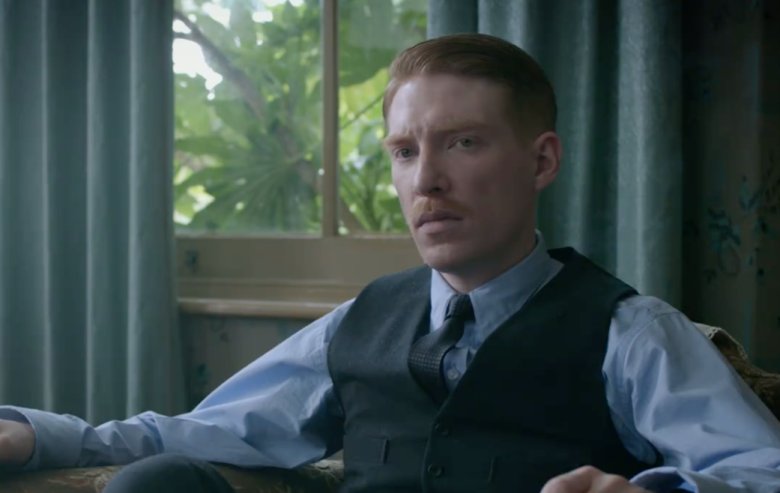The atmospheric horror film tends to get shorter shrift from fans of horror than its more blood-thirsty brothers and sisters. It’s more understated, more psychological, more interested in establishing a sense of horror than in actually showing horrific things. Lenny Abramson’s adaptation of Sarah Waters’s Gothic novel The Little Stranger contains moments of violence, but they are restrained acts that linger at the peripheries of the film, present but often unseen. This is a horror film about the things left unsaid, the resentments left to fester, unexpressed, the eruption of the chaos world within the collective psyche of a nation in decline.
The Little Stranger takes place in 1948, in a rundown great house in the heart of an England ravaged by two world wars and the slow breakdown of the class system. The Ayres family at the center of the story is also fallen upon hard times—the eldest son Roderick (Will Poulter) was disfigured in the war, unwilling to take treatment for his scarred face or damaged leg and turning to alcoholism to cope. His mother Mrs. Ayres (Charlotte Rampling) tries to maintain a stolid facade in the midst of class and cultural upheaval—the world has shifted, the house that was once the symbol of class prosperity is decaying around her, her family scraped down to the bone. Her daughter Caroline (Ruth Wilson) is all that holds Hundreds Hall together, perhaps the only member of the family who could easily take or leave the responsibility of her birth. Into the moldering family comes Dr. Faraday (Domhnall Gleeson), a country doctor returning to his birthplace following the death of his father, who still maintains a particular affection for Hundreds after attending a party there as a child. Faraday becomes a family friend and confidant, but his position is challenged as a series of spooky accidents convinces the Ayreses that some malevolent spirit haunts their home.

The Little Stranger is a subdued film, dealing with the spaces between, the words not spoken, and things not seen. Its moments of horror are stark, but often perfunctorily cut off, avoiding an initial sense of catharsis. The “presence” that haunts the Ayres family manifests in different forms—with Roderick, it is fire that haunts him; with Mrs. Ayres, a reinforcement of her lost daughter. With Caroline, though, it is more complicated, something malign and yet barely there, something that she believes in and that she also rejects. The film, like the novel on which it is based, takes the tack of the haunted house as a manifestation of the human psyche, the presence appearing in bits and pieces and apparently residing in the upper regions. The haunting plays off as more psychological than supernatural—little scribbled S’s appear on the wall, the dog Gyp becomes suddenly vicious, thuds and knocks resound in the upstairs nursery, now closed off.
The class conflict at the heart of The Little Stranger drives the film—it is entirely British, an elucidation of ingrained class hierarchy maintained even in the face of ultimate destruction. The film’s subdued nature reflects in its characters, each of them insular to the point of madness, unable to speak their feelings or, in the case of Dr. Faraday, to even smile. Much of the film is filtered through Faraday’s experience, yet he remains a curiously remote figure, his needs and desires so suppressed that even the viewer cannot completely understand him. The starkness of the world around him, devoid of sunlight, intimacy, or warmth, becomes focused on Hundreds, a world that is open to him as a doctor and closed to him as a middle-class worker, the son of a former maid.
There are elements, however, that the film too quickly elides over, like the onset of Roderick’s supposed madness (which takes up much of the first half of the novel). By slipping so quickly over the reasons behind the fire, The Little Stranger manages to ignore some of the most haunting characteristics of the book. This isn’t really a horror film, but a story about repression and suppression, and so it’s disappointing that such a major part of the narrative, bringing about a shift in the relationships between the characters, should be so elided over.
This film might suffer in comparison to other haunted house films that walk the line between supernatural and psychological horror – it owes a visual and thematic debt to the 1961 version of The Haunting, another film about haunted houses as manifestations of hidden resentment. But The Little Stranger occasionally telegraphs its meaning too clearly, dissipating at least some of the mystery that the novel builds so perfectly. Still, Gleeson’s central performance anchors the film in an unexpected way, his Faraday so suppressed, so desperate for acceptance, set against the aristocratic forbearance of Mrs. Ayres and Caroline’s inherent desperation to escape from the prison of her class. This is a story about people denied emotional openness, humanity, the freedom to express themselves. It is the horror of lives controlled by an unseen force, and the violence that results.
The Little Stranger opens this Friday.


Episode 48: The Little Dame – Citizen Dame
[…] Read Lauren’s Review […]